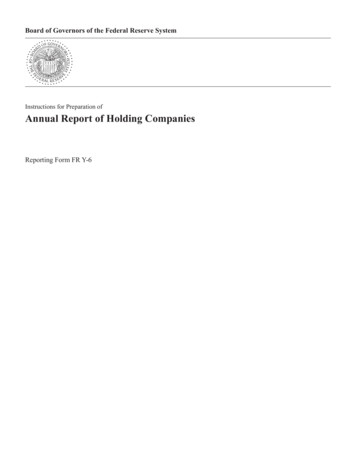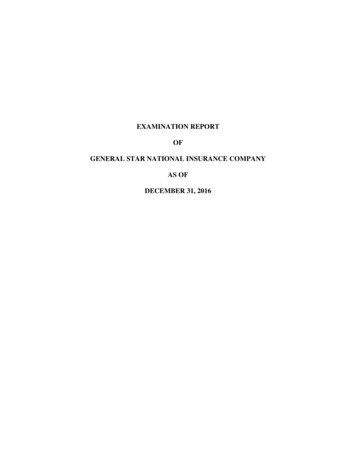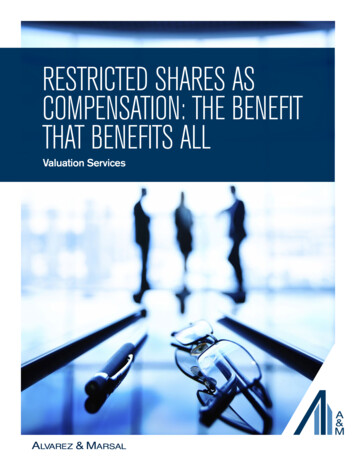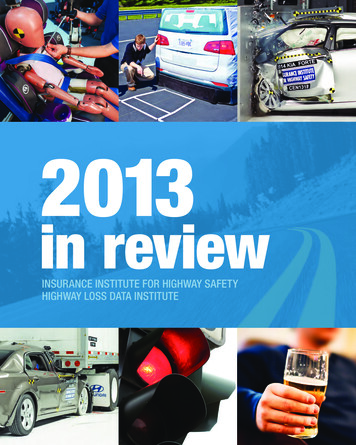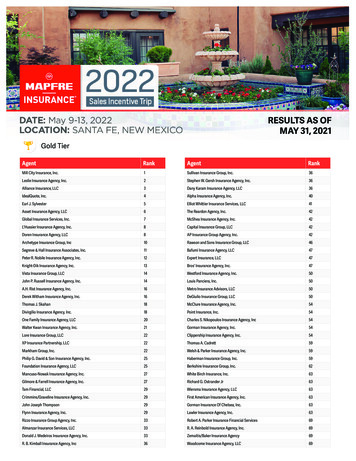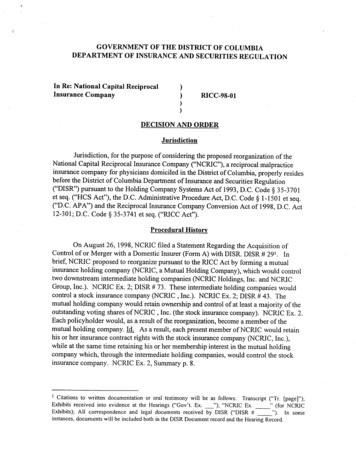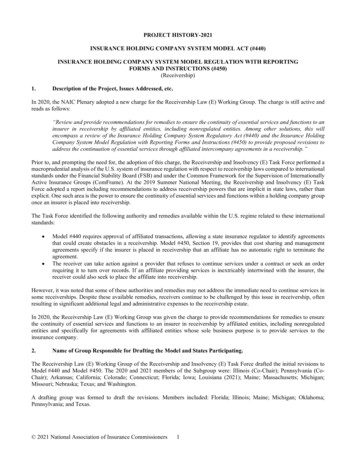
Transcription
PROJECT HISTORY-2021INSURANCE HOLDING COMPANY SYSTEM MODEL ACT (#440)INSURANCE HOLDING COMPANY SYSTEM MODEL REGULATION WITH REPORTINGFORMS AND INSTRUCTIONS (#450)(Receivership)1.Description of the Project, Issues Addressed, etc.In 2020, the NAIC Plenary adopted a new charge for the Receivership Law (E) Working Group. The charge is still active andreads as follows:“Review and provide recommendations for remedies to ensure the continuity of essential services and functions to aninsurer in receivership by affiliated entities, including nonregulated entities. Among other solutions, this willencompass a review of the Insurance Holding Company System Regulatory Act (#440) and the Insurance HoldingCompany System Model Regulation with Reporting Forms and Instructions (#450) to provide proposed revisions toaddress the continuation of essential services through affiliated intercompany agreements in a receivership.”Prior to, and prompting the need for, the adoption of this charge, the Receivership and Insolvency (E) Task Force performed amacroprudential analysis of the U.S. system of insurance regulation with respect to receivership laws compared to internationalstandards under the Financial Stability Board (FSB) and under the Common Framework for the Supervision of InternationallyActive Insurance Groups (ComFrame). At the 2019 Summer National Meeting, the Receivership and Insolvency (E) TaskForce adopted a report including recommendations to address receivership powers that are implicit in state laws, rather thanexplicit. One such area is the power to ensure the continuity of essential services and functions within a holding company grouponce an insurer is placed into receivership.The Task Force identified the following authority and remedies available within the U.S. regime related to these internationalstandards: Model #440 requires approval of affiliated transactions, allowing a state insurance regulator to identify agreementsthat could create obstacles in a receivership. Model #450, Section 19, provides that cost sharing and managementagreements specify if the insurer is placed in receivership that an affiliate has no automatic right to terminate theagreement.The receiver can take action against a provider that refuses to continue services under a contract or seek an orderrequiring it to turn over records. If an affiliate providing services is inextricably intertwined with the insurer, thereceiver could also seek to place the affiliate into receivership.However, it was noted that some of these authorities and remedies may not address the immediate need to continue services insome receiverships. Despite these available remedies, receivers continue to be challenged by this issue in receivership, oftenresulting in significant additional legal and administrative expenses to the receivership estate.In 2020, the Receivership Law (E) Working Group was given the charge to provide recommendations for remedies to ensurethe continuity of essential services and functions to an insurer in receivership by affiliated entities, including nonregulatedentities and specifically for agreements with affiliated entities whose sole business purpose is to provide services to theinsurance company.2.Name of Group Responsible for Drafting the Model and States Participating.The Receivership Law (E) Working Group of the Receivership and Insolvency (E) Task Force drafted the initial revisions toModel #440 and Model #450. The 2020 and 2021 members of the Subgroup were: Illinois (Co-Chair); Pennsylvania (CoChair); Arkansas; California; Colorado; Connecticut; Florida; Iowa; Louisiana (2021); Maine; Massachusetts; Michigan;Missouri; Nebraska; Texas; and Washington.A drafting group was formed to draft the revisions. Members included: Florida; Illinois; Maine; Michigan; Oklahoma;Pennsylvania; and Texas. 2021 National Association of Insurance Commissioners1
3.Project Authorized by What Charge and Date First Given to the Group.As described in paragraph 1 above, the initial charge prompting a review of Model #440 and Model #450 was given to theReceivership Law (E) Working Group for 2020. The Request for NAIC Model Law Development to open Model #440 andModel #450 for revision was adopted by the Executive (EX) Committee at the 2020 Summer National Meeting.4.A General Description of the Drafting Process (e.g., drafted by a subgroup, interested parties, the full group,etc.). Include any parties outside the members that participated.In August 2020, the Receivership Law (E) Working Group began its work to address its charge by conducting a survey of stateinsurance regulators and interested parties to gather feedback on possible provisions to be addressed and goals of those revisionsto Model #440 and Model #450. Survey responses were received from state insurance regulators and interested partiesidentifying specific sections of the models and topics to be considered.5.A General Description of the Due Process (e.g., exposure periods, public hearings, or any other means by whichwidespread input from industry, consumers and legislators was solicited).On Dec. 17, 2020, the Receivership Law (E) Working Group met in open session to expose proposed amendments to Section5A and Section 11 of Model #440 and Section 19 of #450 for a 42-day public comment period ending Jan. 29, 2021. Commentswere received from Florida; the American Council of Life Insurers (ACLI); America’s Health Insurance Plans (AHIP) and theBlue Cross and Blue Shield Association (BCBSA); Arbor Strategies LLC; Morgan, Lewis & Bockius LLP and the NationalOrganization of Life and Health Insurance Guaranty Associations (NOLHGA); and the National Conference of InsuranceGuaranty Funds (NCIGF).On Feb. 4, 2021, the Receivership Law (E) Working Group met in open session to discuss comments received. Subsequentedits were drafted by the drafting group as discussed during the meeting. The Working Group exposed proposed revisedamendments to Section 5A and Section 11 of Model #440 and Section 19 of #450 for a 14-day public comment period endingFeb. 4, 2021. Comments were received from AHIP and the BCBSA; the American Property Casualty Insurance Association(APCIA); Arbor Strategies LLC; and NOLHGA and the NCIGF.On March 4, 2021, the Receivership Law (E) Working Group met in open session to discuss comments received. Subsequentedits were drafted as discussed during the meeting by the drafting group in coordination with the interested parties that hadprovided comments. The Working Group co-chairs released proposed revised amendments to Section 5A(1)(g) of Model #440for a 30-day public comment period ending April 9, 2021. One comment letter was received from the ACLI. The ACLI’sproposed edit was accepted.All exposures were distributed by email to members, interested state insurance regulators and interested parties of both theReceivership Law (E) Working Group and the Receivership and Insolvency (E) Task Force and posted to the NAIC website.All issues raised by members, interested state insurance regulators and interested parties were explained or addressed in therevisions to the original amendments.The amendments were adopted by the Receivership Law (E) Working Group on May 4, 2021.The amendments were adopted by the Receivership and Insolvency (E) Task Force on May 20, 2021.The amendments were adopted by the Financial Condition (E) Committee on July 8, 2021.6.A Discussion of the Significant Issues (items of some controversy raised during the due process and the group’sresponse).There were no unresolved issues of real significance raised during the exposure periods. However, the following issue wasconsidered and addressed by the Receivership Law (E) Working Group. Interested parties requested and provided draftrevisions to the amendments in Section 5.A.(1)(g) regarding the requirement for a bond or deposit that limits the provision toinsurers found to be in a condition of hazardous financial condition or a condition that would be grounds for supervision,conservation or a delinquency proceeding. Interested parties also provided revisions to the subsection and the accompanyingdrafting note that would further define and clarify the circumstances and the agreements to which the subsection could beapplied. The Working Group was agreeable to these changes and accepted interested parties’ revisions. 2021 National Association of Insurance Commissioners2
7.List the key provisions of the model (sections considered most essential to state adoption).The amendments to Model #440 are within Section 5, Standards and Management of an Insurer Within an Insurance HoldingCompany System, and within Model #450 Section 19, Transactions Subject to Prior Notice.8. Section 5A(1) of Model #440o Books and records of the insurer are updated to specifically include data of the insurer, being the propertyof the insurer. The data and records should be identifiable and capable of segregation. Essentially the dataand records should be available to the receiver in the event of insolvency, including the systems necessaryto access them.o If the commissioner deems the insurer to be in a statutorily defined hazardous financial condition, thecommissioner may require a bond or deposit, limited in amount, after consideration of whether there areconcerns about the affiliated party’s ability to fulfill the contract in the event of a liquidation.o Premiums are the property of the insurer, with any right of offset subject to receivership law. Section 5A(6) of Model #440o The affiliated entity is subject to jurisdiction of receivership court, and in certain circumstances thecommissioner may require the affiliate to agree to this in writing. Section 19 of Model #450o Books and records of the insurer are updated to specifically include data of the insurer, being the propertyof the insurer. The data and records should be identifiable and capable of segregation. Essentially the dataand records should be available to the receiver in the event of insolvency, including the systems necessaryto access them. The data is specifically defined in Model #450.o Model #450 includes a provision relating to indemnification of the insurer in the event of gross negligenceor willful misconduct by the affiliate.o In the event of receivership (now including supervision and conservatorship): The rights of the insurer extend to the receiver or guaranty fund. The affiliate will make available essential personnel. The affiliate will continue the services for a minimum period of time as specified in the agreementwith timely payment for post-receivership work. The affiliate will maintain necessary systems, programs or infrastructure and make them availableto the receiver or commissioner for as long as the affiliate receives timely post-receivershippayment unless released by the receiver, commissioner or receivership court.Any Other Important Information (e.g., amending an accreditation standard).The Receivership and Insolvency (E) Task Force has not had formal discussions with respect to whether the current InsuranceHolding Company Systems accreditation standard under the NAIC Financial Regulation Standards and Accreditation Programshould be amended to include the current revisions to Model #440 and Model #450. The Task Force will consider this andmake appropriate referrals prior to the 2022 Spring National Meeting. 2021 National Association of Insurance Commissioners3
PROJECT HISTORY - 2020INSURANCE HOLDING COMPANY SYSTEM MODEL ACT (#440)(Liquidity Stress Testing)1.Description of the Project, Issues Addressed, etc.In April 2017, the Executive (EX) Committee adopted a new charge for the Financial Stability (EX) Task Force at theSpring National Meeting. The charge is still active and reads as follows:“Analyze existing post-financial crisis regulatory reforms for their application in identifying macroeconomictrends, including identifying possible areas of improvement or gaps, and propose to the Financial Condition (E)Committee or other relevant committee enhancements and/or additions to further improve the ability of stateinsurance regulators and the industry to address macroprudential impacts; consult with such committees onimplementation, as needed.”Prior to, and prompting the need for, the adoption of this charge, the Financial Stability (EX) Task Force performed a reviewof other jurisdictions’ activities in the macroprudential space. Common themes noted in this review included a focus on: stresstesting; liquidity assessments, both within specific sectors and cross-sector exposures; enhancing resolution planning anddisclosures; and charts and discussions on various domestic economic/regional trends impacting the insurance sector.After considering these common macroprudential activities against the U.S. system of insurance regulation, the FinancialStability (EX) Task Force adopted a Macroprudential Initiative (MPI) Framework during the 2017 Summer National Meeting.The MPI Framework contained four focused areas for potential enhancements: 1) liquidity; 2) recovery and resolution;3) capital stress testing; and 4) exposure concentrations. During this meeting, liquidity risk was identified as a top priority forMPI, and the Liquidity Risk Assessment (EX) Subgroup was appointed to address this work and assigned the following charges: 2.Review existing public and regulator only data related to liquidity risk, identify any gaps based on regulatory needs,and propose the universe of companies to which any recommendations may apply.Construct a liquidity stress testing framework proposal for consideration by the Financial Condition (E) Committee,including the proposed universe of companies to which the framework will apply (e.g., large life insurers).Name of Group Responsible for Drafting the Model and States Participating.The Liquidity Assessment (EX) Subgroup of the Financial Stability (EX) Task Force drafted the initial revisions to Model #440.The 2020 members of the Subgroup were: Nebraska (Chair); Connecticut; District of Columbia; Florida; Illinois; Iowa;Minnesota; Missouri; and Texas.The Financial Stability (EX) Task Force finalized the liquidity stress test (LST) revisions to Model #440. The 2020 membersof the Task Force were: New Jersey (Chair); Maine (Vice Chair); Arkansas; California; Connecticut; District of Columbia;Florida; Illinois; Iowa; Massachusetts; Missouri; Nebraska; New York; Oregon; Pennsylvania; and Texas.3.Project Authorized by What Charge and Date First Given to the Group.As described in paragraph 1 above, the initial charge prompting a review of the U.S. system of insurance regulation to assessits ability to address macroprudential monitoring was assigned to the Financial Stability (EX) Task Force during the2017 Spring National Meeting. However, the specific charge to create an LST framework—which includes the need to addressregulatory authority for requiring the filing of LST reports and confidentiality protection of those filings—was assigned to theLiquidity Assessment (EX) Subgroup during the 2017 Summer National Meeting and reads as follows:“Construct a liquidity stress testing framework proposal for consideration by the Financial Condition (E) Committee,including the proposed universe of companies to which the framework will apply (e.g., large life insurers).” 2020 National Association of Insurance Commissioners1
4.A General Description of the Drafting Process (e.g., drafted by a subgroup, interested parties, the full group,etc.). Include any parties outside the members that participated.In late 2017, the Liquidity Assessment (EX) Subgroup began its work to address its first charge related to liquidity data gaps,resulting in two blanks proposals to add more product breakout data in the life statutory financial statement or blank. Once theblanks proposals were submitted to the Blanks (E) Working Group, the Subgroup began work on the LST Framework in early2018. The Subgroup first addressed the scope criteria to determine which life insurers should be subject to an LST requirement,which was adopted by the Financial Stability (EX) Task Force during the 2019 Spring National Meeting.To construct the actual LST proposal, the Subgroup utilized an unofficial study group, with members consisting of Nebraska(lead), Connecticut, Iowa, Minnesota, Missouri, New Jersey and Texas. Also, the study group included industry participantsfrom some of the insurers triggering the initial scope criteria; specifically, John Hancock, Manulife, MassMutual, MetLife,New York Life, Principal and Prudential. At times, the lead states of, and industry participants from, all 23 insurers triggeringthe initial scope criteria were included in study group calls.Work on the LST Framework proposal continued until the COVID-19 pandemic prompted the Financial Stability (EX) TaskForce to place the LST Framework development on hold effective April 17, 2020. Importantly, this pause did not include anywork related to addressing regulatory authority for the LST and confidentiality of the LST reports, which, pursuant to aFeb. 26, 2020 call of the Financial Stability (EX) Task Force, was to initially consider using revisions to Model #440. Instead,the Subgroup and study group were directed to obtain data from the 23 insurers to assess how liquidity stress was impacted bythe pandemic and subsequent economic stresses. In November 2020, the study group expressed its intent to resume the workto develop the LST proposal.For the actual proposed revisions to Model #440 required for LST needs, NAIC staff worked with Justin Schrader (NE), chairof the Liquidity Assessment (EX) Subgroup, to draft the initial exposure document. The current version of edits exposed bythe Group Capital Calculation (E) Working Group were used as the baseline for Model #440 and were edited for LST needs.5.A General Description of the Due Process (e.g., exposure periods, public hearings, or any other means by whichwidespread input from industry, consumers and legislators was solicited).On June 23, 2020, Justin Schrader (NE), chair of the Liquidity Assessment (EX) Subgroup, exposed proposed revisions toModel #440 for a public comment period ending July 29, 2020. Comments were received from the Texas Department ofInsurance (TDI) and the American Council of Life Insurers (ACLI). The TDI comments were suggestions for how to organizethe revisions within Model #440, consistent with similar comments made with respect to the Group Capital Calculation (E)Working Group’s exposed revisions, and were all acceptable to the Liquidity Assessment (EX) Subgroup members. All butone of the ACLI comments, most with respect to governance and timing issues, were acceptable to the Liquidity Assessment(EX) Subgroup members.On Aug. 31, 2020, an updated draft of proposed revisions to Model #440 was posted as materials for the Sept. 1, 2020, meetingof the Liquidity Assessment (EX) Subgroup. Because there were so few comments received during the initial comment periodand all comments were accepted except one ACLI comment, a second exposure period was not deemed necessary for theLiquidity Assessment (EX) Subgroup. Rather, the Liquidity Assessment (EX) Subgroup voted to forward the proposedrevisions to Model #440—as modified during its Sept. 1, 2020, conference call to partially address the outstanding ACLIcomment—to the Financial Stability (EX) Task Force for a final exposure period.On Sept. 3, 2020, Commissioner Marlene Caride (NJ), chair of the Financial Stability (EX) Task Force, exposed for a publiccomment period ending Oct. 5, 2020, the Liquidity Assessment (EX) Subgroup’s modified proposed revisions to Model #440.One comment letter was received, from the ACLI, requesting several editorial changes that were made for the proposedrevisions to Model #440 included as materials for the meeting of the Financial Stability (EX) Task Force held Oct. 13, 2020.Several items were raised as concerns with respect to the proposed revisions during the Financial Stability (EX) Task Force’sOct. 13, 2020, conference call, but all were resolved with recommended changes that satisfied the members. As such, on theOct. 13, 2020, conference call of the Financial Stability (EX) Task Force, the members voted to adopt the modified proposedrevisions to Model #440 and forward them to the Financial Condition (E) Committee for its consideration. 2020 National Association of Insurance Commissioners2
6.A Discussion of the Significant Issues (items of some controversy raised during the due process and the group’sresponse).There were no issues of real significance raised during the exposure periods. However, these are the items discussed during thefinal consideration by the Financial Stability (EX) Task Force:a.b.c.d.7.The ACLI request to limit the use of the LST data to macroprudential purposes only was rejected by stateinsurance regulators, given that microprudential oversight of legal entity insurers and groups will benefit fromthis data also.Confirmed the need to change “assets and liabilities” to “exposure bases” in the scope criteria definition asrecommended by the ACLI.Agreed with the TDI request to specify that the LST data is still owned by the lead state when a consultant is used.Changed “in conjunction with” to “in consultation with” to clarify that the lead state makes the final decision interms of when an insurer is added to or removed from the list of insurers required to perform the LST for aspecific year.List the key provisions of the model (sections considered most essential to state adoption).The changes to Section 4L(3) of Model #440 are the most important provisions in the proposed changes, as they require theultimate controlling person of every insurer subject to registration and meeting the scope criteria to file the results of a specificyear’s LST to the lead state insurance commissioner. The filing shall be made in accordance with the procedures housed withinthe Financial Analysis Handbook.Immediately following this provision in Section 4L(3)(a) of Model #440 is the information regarding the scope criteria andindication that the lead state commissioner, in consultation with the Financial Stability (EX) Task Force or its successor, willmake the final determination regarding the insurers that will be scoped in and out of a specific data year’s LST.Section 4L(3)(b) of Model #440 indicates the performance of, and filing of the results from, a specific year’s LST shall complywith the NAIC LST framework’s instructions and reporting templates for that year, along with any lead state insurancecommissioner determinations (in consultation with the Financial Stability (EX) Task Force or its successor).Finally, Section 8(A)(2) of Model #440 provides key statutory authority to hold the LST confidential.8.Any Other Important Information (e.g., amending an accreditation standard).It is considered extremely important that lead states of insurance companies that are considered to be internationally activeinsurance groups (IAIGs) under Model #440 enact these LST revisions. However, it is also important to make the LST revisionsto Model #440 an accreditation standard applicable to all states in order to develop a macroprudential surveillance program forthe U.S. state-based insurance regulatory system. Each state has primarily microprudential goals in order to regulate individualinsurers’ solvency, which extend to insurance groups, as well. But all commissioners do have macroprudential goals withrespect to having competitive markets in their respective states. However, no state has a complete purview of the entireU.S. insurance industry, or even the entire U.S. life insurance segment. Federal regulators and the U.S. insurance industry havestrongly encouraged the creation of a macroprudential framework throughout the states, and this LST should become a baselineelement in the overall financial solvency regulation of insurance. 2020 National Association of Insurance Commissioners3
PROJECT HISTORY - 2020INSURANCE HOLDING COMPANY SYSTEM MODEL ACT (#440)INSURANCE HOLDING COMPANY SYSTEM MODEL REGULATION WITH REPORTINGFORMS AND INSTRUCTIONS (#450)(Group Capital Calculation (GCC))1.Description of the Project, Issues Addressed, etc.In 2015, the NAIC Plenary adopted a charge to the Financial Condition (E) with respect to the construction of a group capitalcalculation (GCC). The Financial Condition (E) Committee subsequently formed the Group Capital Calculation (E) WorkingGroup to carry out the following charge:“Construct a U.S. group capital calculation using an RBC aggregation methodology; liaise as necessary with theComFrame Development and Analysis (G) Working Group on international capital developments and considergroup capital developments by the Federal Reserve Board, both of which may help inform the construction of aU.S. group capital calculation.”The charge was developed primarily as a result of discussions that revealed that developing a GCC was a natural extension ofwork that state insurance regulators had already begun on group supervision as a result of the lessons learned from the2008 financial crisis. While state insurance regulators currently have the authority to obtain information regarding the capitalpositions of non-insurance affiliates, they do not have a consistent analytical framework for evaluating such information. TheGCC is designed to address this shortcoming and will serve as an additional financial metric that will assist state insuranceregulators in identifying risks that may emanate from a holding company system. More specifically, the GCC and relatedreporting provides more transparency to state insurance regulators regarding insurance groups and make risks more identifiableand more easily quantified.It is important to understand that the GCC utilizes an aggregation approach to group capital where existing legal entity capitalrequirements [e.g., risk-based capital (RBC)] and existing valuation for capital (e.g., statutory accounting) are utilized. Inselecting this approach, it was recognized as satisfying state regulatory needs while at the same time having the advantages ofbeing less burdensome and costly to regulators and the industry, in addition to respecting other jurisdictions’ existing capitalregimes. To capture the risks associated with the entire insurance group, including the insurance holding company, calculationswere developed in those instances where no RBC calculations currently exist (i.e., non-regulated entities) and are part of theGCC. The methods selected were tested in 2019 by more than 30 insurance groups representing 15 lead states. These methodshave since been modified to consider the lessons learned from the testing and subsequent comments from the industry and stateinsurance regulators. The more significant items are discussed in paragraph 6 below.Also important in finalizing the GCC was the scope of groups that would be required to complete it. Specifically, Model #440exempts single-state companies, insurers located in reciprocal jurisdictions that have already recognized the U.S. approach togroup supervision and group capital, as well as other jurisdictions that agree to recognize the U.S. approach to group capital.Model #450 also provides commissioners with additional discretion to exempt groups that have less than 1 billion in premium,provided the group has no non-U.S. insurers, has no banks or similar financial institutions, and has non-risky non-regulatedentities within the group.2.Name of Group Responsible for Drafting the Model and States Participating.The Group Capital Calculation (E) Working Group of the Financial Condition (E) Committee drafted the revisions toModel #440 and Model #450. The 2020 members of the Working Group were: Florida (Chair); Connecticut (Vice Chair);California; District of Columbia; Illinois; Indiana; Iowa; Massachusetts; Michigan; Minnesota; Missouri; Nebraska;New Jersey; New York; North Carolina; Ohio; Oregon; Pennsylvania; Tennessee; Texas; Virginia; and Wisconsin.3.Project Authorized by What Charge and Date First Given to the Group.At the 2015 Fall National Meeting, the Financial Condition (E) Committee received the following charge:“Construct a U.S. group capital calculation using an RBC aggregation methodology; liaise as necessary with theComFrame Development and Analysis (G) Working Group on international capital developments and consider group 2020 National Association of Insurance Commissioners1
capital developments by the Federal Reserve Board, both of which may help inform the construction of a U.S. groupcapital calculation.”4.A General Description of the Drafting Process (e.g., drafted by a subgroup, interested parties, the full group,etc.). Include any parties outside the members that participated.The Group Capital Calculation (E) Working Group began its work on the GCC in 2016 and spent the next two-and-one-halfyears constructing the calculation. Over the course of that time, the Working Group conducted numerous public conferencecalls to discuss the proposed construction on a topic-by-topic basis. In 2019, the Working Group set up a voluntary processunder which the GCC was tested by more than 30 insurance groups represented by 15 lead states. This testing was completedin early 2020, at which time the Working Group began to make changes to the GCC to reflect the learnings from the testing.Simultaneously with this testing, at the 2019 Fall National Meeting, the Executive (EX) Committee approved the WorkingGroup’s request to open Model #440 and Model #450 to develop the legal authority under which the GCC would beimplemented. In addition to requiring the filing of the GCC with the lead state commissioner, the models would also provideinformation on the types of insurance groups that would be exempt from filing the GCC, as well as provide the necessarylanguage to protect the confidentiality of the tool.In January 2020, the Working Group exposed for public comment a draft memorandum
Organization of Life and Health Insurance Guaranty Associations (NOLHGA); and the National Conference of Insurance Guaranty Funds (NCIGF). . (MPI) Framework during the 2017 Summer National Meeting. . the . INSURANCE HOLDING COMPANY SYSTEM MODEL ACT (#440) INSURANCE HOLDING COMPANY SYSTEM MODEL REGULATION WITH REPORTING .
